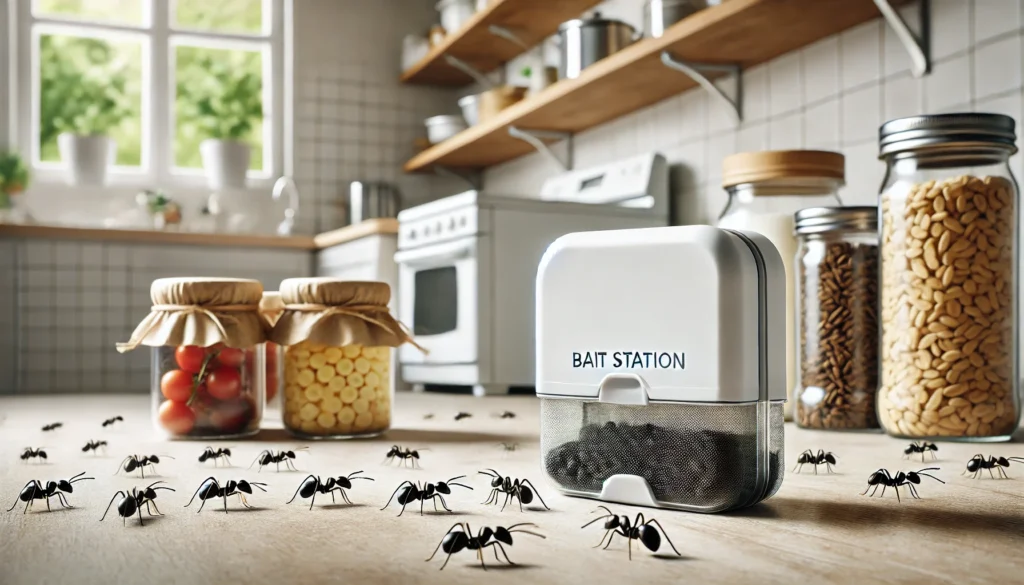Dealing with small black ants in the kitchen can be frustrating, especially when they seem to appear out of nowhere. These ants invade kitchens in search of food, water, and shelter. If left untreated, they can quickly establish colonies and become a persistent problem. Fortunately, getting rid of them doesn’t have to be complicated.
This step-by-step guide will walk you through effective ways to eliminate small black ants from your kitchen permanently. From identifying their entry points to using natural remedies and chemical solutions, you’ll learn everything you need to maintain an ant-free home.
By following these steps, you can prevent future infestations and ensure your kitchen remains clean and pest-free. Let’s start by understanding why these ants invade in the first place.
Introduction
Ants are one of the most common household pests, and small black ants are particularly notorious for invading kitchens. These tiny creatures may seem harmless, but they can contaminate food and create hygiene issues. Understanding why they invade your kitchen is the first step toward getting rid of them.
Ants are social insects that work in colonies. They send out scout ants to search for food sources. If a scout finds a reliable source, it leaves behind a pheromone trail, attracting more ants to the area. This is why you often see them marching in lines toward food crumbs or spills.
If you don’t take immediate action, a small ant problem can quickly escalate into a full-blown infestation. While some home remedies work temporarily, a thorough approach that includes eliminating attractants, sealing entry points, and using targeted ant treatments is essential.
Now, let’s dive into the specifics of why these ants invade kitchens.
Why Are There Small Black Ants in My Kitchen?
Small black ants are drawn to kitchens primarily for food and water. Kitchens provide the perfect environment for them to thrive due to food crumbs, spills, and moisture. Even the smallest food residue can attract an entire colony of ants.
Here are some common reasons why ants invade kitchens:
- Food availability: Unsealed food items, crumbs on the counter, and sugary spills act as strong attractants for ants.
- Water sources: Ants need water to survive, and leaky pipes, wet sinks, and standing water provide them with the moisture they need.
- Shelter: Kitchens have multiple cracks and crevices where ants can establish their nests, making it easy for them to settle in.
To get rid of ants effectively, it’s important to remove these attractants and make your kitchen less appealing to them.
Understanding Ant Behavior: Why They Keep Coming Back
Even after cleaning, you might find ants returning to your kitchen. This happens because ants rely on pheromone trails to communicate with their colony members. When one ant finds food, it leaves a trail for others to follow.
Another reason they return is that their nests may be located nearby. If you only kill the visible ants without targeting their colony, the problem will persist. Additionally, certain ant species send out satellite colonies, meaning they can spread to different areas of your home.
The key to breaking this cycle is eliminating their pheromone trails, sealing entry points, and using effective treatments to target the colony itself.
Are Small Black Ants Dangerous?
While small black ants are not directly harmful to humans, they can pose hygiene risks. Since they crawl over dirty surfaces before invading your kitchen, they can transfer bacteria and contaminate food.
In rare cases, some species of small black ants can bite, but their bites are generally harmless. The bigger concern is their ability to infest food supplies, leading to waste and potential health hazards.
If you have pets, you should also be cautious. Some ants are attracted to pet food, and their presence can be irritating to your furry friends.
Step 1: Identify the Source of the Infestation
Before you can get rid of ants, you need to locate their entry points and nesting areas. Simply killing the ants you see will not solve the problem if their colony remains active.
Start by observing their movement patterns. Where are they coming from? Are they entering through windows, cracks, or gaps in the floor? Identifying their entry points is crucial for effective treatment.
In the next section, we’ll explore how to track ant trails, common entry points, and what these ants are searching for in your kitchen.
How to Track the Ant Trail
Tracking ant trails is crucial in identifying their entry points and understanding their movement patterns. Ants do not randomly appear; they follow a structured route determined by pheromone trails left by scout ants.
To track their trail, observe the ants closely and follow their movement. Here’s how you can do it:
- Watch their path: Look for a steady line of ants leading to food or water sources.
- Follow the trail: Trace their movement backward to see where they are entering from.
- Check common hiding spots: Ants often come from small cracks in walls, under cabinets, or even behind kitchen appliances.
- Use a flashlight: If the trail disappears under cabinets or into dark spaces, a flashlight can help you see better.
Once you identify their entry point, you can take the necessary steps to block it and cut off their access to your kitchen.
Now, let’s explore the most common places where ants enter your kitchen.
Common Entry Points in the Kitchen
Small black ants can squeeze through the tiniest cracks and gaps. Some of the most common entry points include:
- Windows and doors: Unsealed windows and gaps under doors allow ants to enter easily.
- Cracks in walls and flooring: Even tiny openings in the walls or floors provide access for ants.
- Pipes and drains: Ants often travel through plumbing lines and enter through sink drains.
- Vents and electrical outlets: Air vents and small gaps around electrical sockets are also potential entry points.
By sealing these entry points with caulk or weather stripping, you can prevent ants from getting inside.
Now that we know how ants enter, let’s discuss what exactly they are looking for in your kitchen.
What Are They Looking For? (Food, Water, Shelter)
Ants invade kitchens mainly for three things: food, water, and shelter. Understanding their motivations will help you eliminate attractants and prevent future infestations.
Food Sources
Ants are particularly attracted to:
- Sugary foods: Spilled juice, honey, and fruit attract ants quickly.
- Crumbs and leftovers: Even small crumbs on the floor or counter can draw ants.
- Greasy residues: Uncleaned stovetops and greasy dishes can be a food source.
Water Sources
Ants need moisture to survive, and they look for:
- Leaky faucets and pipes: Constantly dripping water attracts ants.
- Wet sponges and dishcloths: Leaving damp items around provides them with a water source.
- Pet water bowls: Standing water in pet dishes can also be a target.
Shelter and Nesting Areas
Some ants may be nesting inside your home, especially if they find:
- Warm, dark places: Behind kitchen cabinets, under sinks, and near appliances.
- Wooden structures: Some ants nest in damp wood, making wooden cabinets vulnerable.
- Wall voids and cracks: If they find a safe nesting spot, they will establish colonies.
By removing these attractants, you can make your kitchen less appealing to ants.
Step 2: Clean and Remove Attractants
Now that we’ve identified why ants invade, the next step is to eliminate the things that attract them. Cleaning is the most effective way to prevent ants from returning.
A deep-cleaned kitchen ensures that no food particles, grease, or moisture are left behind. Let’s break down the cleaning process into key areas.
Proper Food Storage Techniques
Ants have a keen sense of smell and can detect food from far away. To prevent infestations, store food properly:
- Use airtight containers: Store dry goods like flour, sugar, and cereal in sealed containers.
- Keep fruit covered: If you leave fruit out, use a mesh cover or store it in the fridge.
- Seal pet food: Don’t leave pet food sitting out; store it in an airtight container.
Additionally, avoid leaving open food packages in the pantry, as ants can chew through cardboard or thin plastic packaging.
Now, let’s talk about cleaning surfaces to remove food residue and spills.
Wiping Down Counters and Surfaces
Ants are drawn to even the smallest crumbs or food particles left behind. Here’s how to keep surfaces clean:
- Use a disinfectant spray: Wipe counters, tables, and stovetops with a vinegar-water solution or an antibacterial cleaner.
- Clean up spills immediately: Even a few drops of juice or syrup can attract ants.
- Sweep and mop regularly: Crumbs often fall to the floor, so daily sweeping and mopping help eliminate them.
By keeping surfaces clean, you remove the food sources that sustain ant colonies.
Now, let’s look at how taking out the trash plays a role in ant prevention.
Taking Out the Trash Regularly
Trash cans are a major attractant for ants, especially if they contain food scraps. Follow these steps to keep ants away from your garbage:
- Use a trash can with a lid: Open trash bins allow ants easy access.
- Empty the trash daily: Even if the bin isn’t full, take it out regularly to prevent buildup.
- Clean the trash can itself: Occasionally wash the bin with soap and water to remove food residue.
A clean and properly managed trash system significantly reduces the chances of an ant infestation.
Now, let’s move on to another critical area—cleaning kitchen appliances and the sink area.
Cleaning Kitchen Appliances and Sink Area
Ants are often found near sinks and appliances, where they can find food scraps and water. Here’s how to keep these areas clean:
- Sink area:
- Wash dishes immediately after use.
- Clean and dry the sink every night.
- Fix any leaky pipes to remove moisture sources.
- Appliances:
- Wipe down the microwave, toaster, and stove after use.
- Clean underneath and behind the fridge, as crumbs often accumulate there.
- Empty and clean the crumb tray in your toaster.
A spotless kitchen makes it difficult for ants to survive.
Step 3: Use Natural Remedies to Repel Ants
After cleaning your kitchen, the next step is using natural solutions to repel ants. These methods are safe, effective, and environmentally friendly.
Cinnamon, Coffee Grounds, and Essential Oils
Certain household items work as powerful ant deterrents due to their strong scents, which disrupt ant pheromone trails.
Cinnamon
Cinnamon is a natural ant repellent with a strong aroma that ants dislike. To use it:
- Sprinkle ground cinnamon along ant trails and entry points.
- Mix a few drops of cinnamon essential oil with water and spray around baseboards, windows, and kitchen corners.
- Replace the cinnamon powder every few days for continued effectiveness.
Coffee Grounds
Used coffee grounds can also deter ants due to their acidity and strong scent. To use:
- Sprinkle used coffee grounds in areas where ants appear.
- Place them near trash bins and kitchen corners.
- Refresh the grounds every few days.
Essential Oils (Peppermint, Tea Tree, Eucalyptus)
Essential oils contain strong scents that disrupt ant trails. To make an ant-repelling spray:
- Mix 10 drops of peppermint or tea tree oil with one cup of water.
- Spray the solution along ant entry points and kitchen surfaces.
- Repeat every few days for best results.
These natural solutions not only repel ants but also leave your kitchen smelling fresh.
Diatomaceous Earth for Long-Term Control
Diatomaceous earth (DE) is a natural powder made from fossilized algae. It is non-toxic to humans and pets but lethal to ants as it dehydrates their exoskeletons.
How to Use DE for Ant Control
- Choose food-grade DE, as it is safe for kitchen use.
- Sprinkle a thin layer of DE along baseboards, windowsills, and ant trails.
- Reapply after cleaning or exposure to moisture since DE loses effectiveness when wet.
DE provides long-term ant control without harmful chemicals.
Step 4: Set Up Ant Baits and Traps

If natural remedies don’t eliminate the infestation, setting up ant baits and traps can be a more aggressive approach.
Choosing the Right Ant Bait (Liquid vs. Gel vs. Solid)
Ant baits contain slow-acting poison that worker ants carry back to their colony, killing the entire nest over time.
- Liquid baits: Best for sugar-loving ants. The liquid formula is easy for ants to consume and transport.
- Gel baits: Effective for various ant species and can be applied in cracks and crevices.
- Solid baits: Suitable for protein-seeking ants. These baits resemble food particles.
Using the correct bait ensures maximum effectiveness in eliminating the colony.
Where to Place Ant Baits for Maximum Effectiveness
To make the bait work efficiently:
- Place near ant trails where ants are actively foraging.
- Avoid spraying insecticides near baits, as it can deter ants from taking the poison.
- Do not disturb the bait stations, even if you see ants swarming.
- Check and replace baits regularly to ensure a continuous supply.
Strategic placement ensures that ants carry the bait back to their colony for complete eradication.
How Long Do Ant Baits Take to Work?
Ant baits are not an instant solution, but they provide long-term results.
- Within 24-48 hours, worker ants will begin transporting the poison to the colony.
- In 3-7 days, the queen and other colony members will start dying.
- After 2 weeks, most ant activity should significantly decrease.
Patience is key when using ant baits, as they work by eliminating the entire colony.
Read More: how to get rid of sugar ants in the kitchen
Step 5: Seal Entry Points and Prevent Future Infestations
After eliminating the ants, the next step is to prevent their return by sealing entry points.
Caulking Cracks and Gaps in Walls and Floors
Ants enter through the smallest cracks, so sealing these openings is essential.
Steps to Seal Cracks
- Inspect walls, floors, and baseboards for tiny openings.
- Use silicone caulk to fill any cracks and gaps.
- Check under sinks and cabinets for additional openings and seal them.
- Reapply caulk annually to maintain protection.
Sealing these gaps ensures ants cannot re-enter your home.
Installing Door Sweeps and Weather Stripping
Gaps under doors and around windows allow ants to enter freely.
- Install door sweeps on exterior doors to block entry points.
- Replace worn-out weather stripping on windows and doors.
- Ensure tight-fitting screens on windows to prevent entry.
These simple fixes can significantly reduce the chances of an ant infestation.
Fixing Leaky Pipes and Reducing Moisture
Moisture attracts ants, especially in humid environments.
- Fix leaky faucets and pipes to remove water sources.
- Use a dehumidifier if your kitchen has high humidity.
- Wipe down the sink every night to keep it dry.
By eliminating moisture, you make your kitchen less appealing to ants.
Step 6: Consider Chemical Solutions (If Necessary)
If natural remedies and baits don’t work, chemical solutions may be needed.
Safe Ant Sprays for Kitchen Use
When choosing an ant spray, opt for kitchen-safe, non-toxic options.
- Look for food-safe formulas labeled for indoor use.
- Spray along baseboards, windows, and cracks, but avoid food prep areas.
- Use caution around children and pets, following label instructions.
Ant sprays provide immediate results but should be used as a last resort.
How to Use Ant Killer Without Harming Pets and Children
To ensure safety:
- Use pet-friendly ant baits, such as borax-based traps.
- Keep sprays and powders out of reach of children and animals.
- Clean treated areas thoroughly before preparing food.
Proper handling ensures effective ant control without health risks.
When to Call a Professional Exterminator
If the infestation persists despite all efforts, hiring a professional is the best option.
- Call an exterminator if ants keep returning after treatments.
- Seek help for large infestations that home remedies can’t control.
- A professional can locate hidden nests and use stronger treatments.
Sometimes, expert intervention is necessary for complete eradication.
Read More: how to get rid of tiny black ants in the kitchen
Step 7: Maintain a Clean and Ant-Free Kitchen
Once the ants are gone, daily habits will prevent future infestations.
Daily Cleaning Habits to Keep Ants Away
Keeping your kitchen clean is the easiest way to prevent ants.
- Wipe down counters and stovetops daily to remove food residues.
- Vacuum and sweep floors regularly to pick up crumbs.
- Take out the trash every night to avoid attracting pests.
These small daily actions make a big difference in keeping ants away.
Storing Food in Airtight Containers
Proper food storage eliminates food sources for ants.
- Store dry goods in sealed containers rather than open packages.
- Keep pet food sealed and avoid leaving it out overnight.
- Refrigerate ripe fruits to prevent attracting ants.
Airtight storage ensures that ants cannot access your food supply.
Regularly Inspecting the Kitchen for Early Signs of Ants
Early detection prevents infestations from worsening.
- Check for ant trails and scout ants near windows and baseboards.
- Inspect under appliances and sinks for hidden food debris.
- Seal cracks and leaks immediately upon spotting them.
A proactive approach keeps your kitchen ant-free.
Conclusion About How to Get Rid of Small Black Ants in the Kitchen
Summary of Key Steps to Get Rid of Small Black Ants
By identifying the source, removing attractants, using natural remedies, and sealing entry points, you can eliminate ants and prevent them from returning.
When to Seek Professional Help
If DIY methods fail, a professional exterminator can provide long-term solutions.
How to Keep Your Kitchen Ant-Free Permanently
A combination of cleanliness, proper food storage, and routine maintenance ensures an ant-free kitchen for good.

